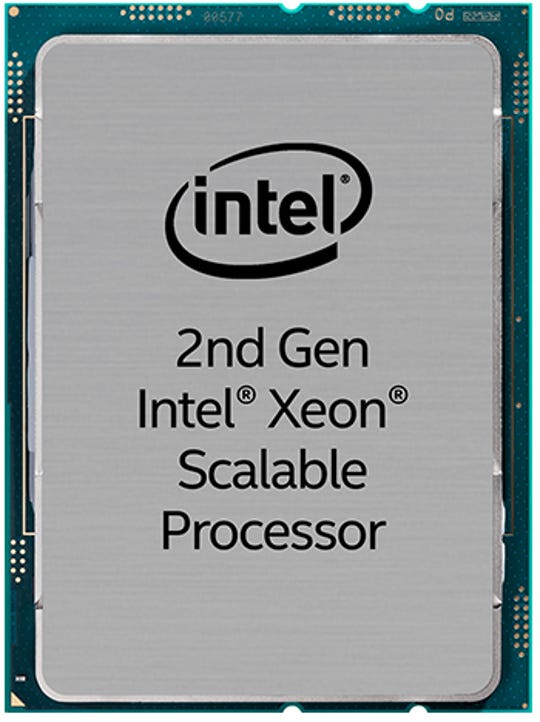Intel pushes back into the game with new silicon portfolio for 5G infrastructure

Not even a year after Intel sold its 5G modem business to Apple, the chip giant has announced a new silicon portfolio for 5G infrastructure.
"When you think about what's really necessary to drive solutions at the edge, we realised that a broad silicon portfolio and robust ecosystem aren't enough. As a result, we must have the right software to address the diverse needs at the edge and accelerate time to market for our customers," Intel corporate VP and GM of both the network platforms and data platforms groups Dan Rodriguez told media.
Intel's burst back into 5G saw the company announce on Monday an enhanced 2nd generation Xeon Scalable processor, Intel Atom P5900, Diamond Mesa, and an Ethernet 700 series adapter.

Intel 2nd generation Xeon Scalable processor
"In collaboration with the world's 5G leaders, we are excited to bring to market the world's first standard high volume silicon foundation for mobile access networks and a highly integrated Intel 10 nanometre SoC, the Intel Atom P5900. delivers what customers require for 5G base stations today and well into the future," Intel corporate VP, GM for the Xeon and memory group and data platforms group Lisa Spelman said.
The Intel 2nd generation Xeon Scalable processor comes boasting on average 36% more performance and up to 3.9GHZ base frequency, or up to 4.5GHZ turbo frequency.
With "more cores, more threads, more cache", Spelman said the 2nd generation Xeon Scalable processor continues to be the only CPU with artificial intelligence (AI) acceleration built in.
Spelman said the Xeon still includes AI acceleration, hardware-enhanced security, and built-in encryption acceleration as the existing Intel Xeon Scalable processor does, but it has had an upgrade to performance and capability.
"It can run any workload and is the foundation for artificial intelligence … it's also the only CPU on the market that features integrated deep learning acceleration," she added.
"Most customers beginning their AI journey are starting with Xeon as the standard for deep learning inference in the data centre … we also see our cloud service providers investing in their inference workloads on Xeon because of the way it fits in with the workload flow and delivers excellent performance."
She said China Mobile was one customer using Xeon for its 5G core network rollout, and similarly T-Mobile Poland is using Xeon for high-density, general purpose cloud and expanding telco workloads. Sprint, Century Link, and SK Telecom are also Xeon customers.
Intel Atom P5900
"With 5G, we see more and more compute being pushed out to the edge closer to where the data is being created and consumed," added Rodriguez.
According to Rodriguez, the Atom P5900 processor was designed from the ground up to meet the needs of the radio access network. Touting the product as being designed for 5G's high bandwidth and low latency requirements, he said the Atom P5900 combines compute, connectivity, and acceleration technology.
"This was a huge step in our journey to transform the network as we bring IA to the base station," he said. "The Atom P5900 delivers what customers require for 5G base stations and today and into the future."
Diamond Mesa, the Intel eASIC
Intel's new structured 5G ASIC chip, Diamond Mesa, comes after it scooped up eASIC in mid-2018.
Intel is calling it the "first next-generation structured ASIC for 5G network acceleration".
The company said it has been designed to complement its existing portfolio of processors and FPGAs, delivering the high performance and low latency required for 5G networks.
Diamond Mesa, Rodriguez said, delivers 2x higher performance, for up to 50% lower power, than the previous generation.
"Structured ASICs like Diamond Mesa provide a minimum-risk optimisation path for workloads that do not require the full programmability of FPGAs, targeting double the performance efficiency versus the prior generation," Intel wrote in a press release.
Diamond Mesa is open to early access customers.
Intel Ethernet 700 series adapter
Rodriguez explained that the Intel Ethernet 700 series network adapter with hardware-enhanced precision time protocol (PTP) delivers the low latencies required for edge services, making it an "ideal product for 5G infrastructure".
"This was designed specifically for 5G and other use cases that have very tight latency and timely requirements," he said.
The product will enter into production in the second quarter of this year.
During the media briefing, Rodriguez said in addition to the RAN and core network, Intel has made investments to enable "all sorts of new services to run on the edge", including investing in CPUs and acceleration technology.
The announcements this week from Intel were originally slated to be made during MWC in Barcelona, however, Intel pulled out earlier this month and the annual event was eventually cancelled over growing coronavirus concerns.
MORE FROM INTEL
- Cloud arms race buys Intel time, massive profits, but indigestion likely
- Intel delivers a strong Q4 in spite of challenges
- Report suggests Intel is preparing for a price war with AMD
- Intel retook semiconductor top spot from Samsung in 2019
- CES 2020: Intel previews Tiger Lake mobile processors and discrete GPU
- CES 2020: Intel launches NUC 9 Extreme, NUC 9 Pro Workstation mini-PC kits
- The desktop is dead, and Intel's NUC killed it: AMD to build a SFF PC kit (TechRepublic)